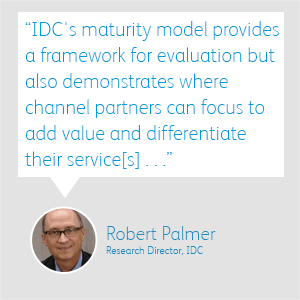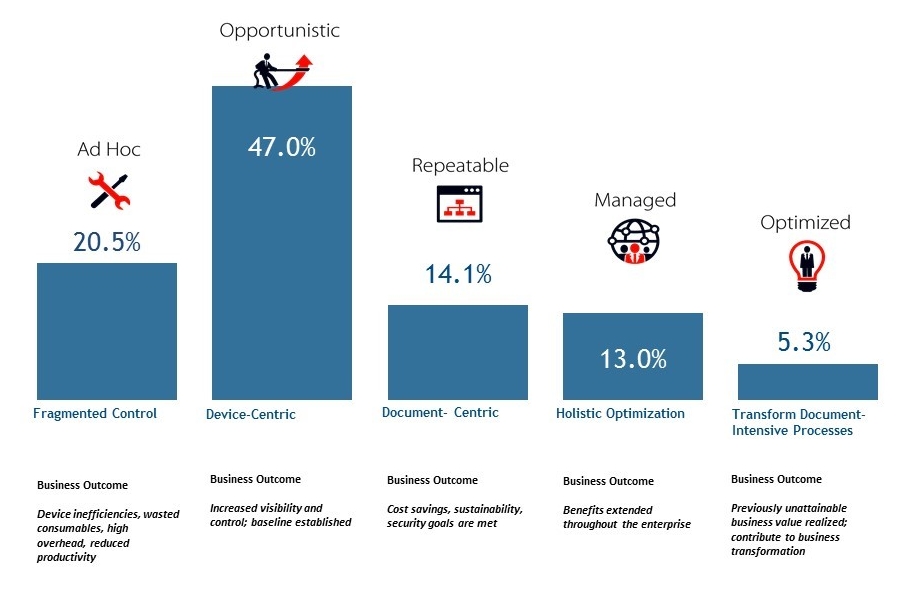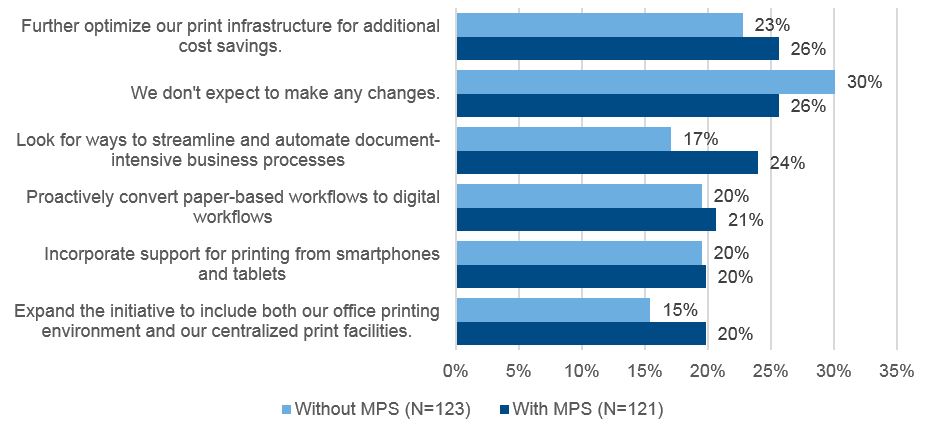 Print and document management (PDM) initiatives are crucial to an organization’s ability to optimize its imaging and printing infrastructure and document-intensive business processes. Businesses can realize significant cost and productivity advantages by advancing to higher levels of print and document maturity.
Print and document management (PDM) initiatives are crucial to an organization’s ability to optimize its imaging and printing infrastructure and document-intensive business processes. Businesses can realize significant cost and productivity advantages by advancing to higher levels of print and document maturity.
Compelling PDM strategies have evolved beyond management of the output infrastructure to include policy-driven initiatives focused on optimization and automation of paper-based business processes. Organizations leading in these areas are typically characterized by their ongoing investments in people, technology, and device infrastructure to support long-term PDM initiatives
Even so, many organizations lack the necessary vision, resources, and device infrastructure to build out a comprehensive program. This is especially true for small- to medium-size businesses (SMBs), which typically do not have the budget or internal resources to devote to these tasks. By gaining a better understanding of these challenges, channel partners can design more effective MPS practices to help businesses improve their print and document management strategies.
IDC has developed the print and document management maturity model, identifying five stages of PDM maturity and the critical competencies, measures, outcomes, and actions that are required for organizations to improve PDM strategies. In addition, IDC has established a benchmark study on print and document management. Together, the two studies provide a comprehensive framework for IDC’s print and document management maturity model, while providing additional insight into the current landscape for managed print and document services.
A Look at the IDC PDM MaturityScape
Our maturity model for print and document management describes the organizational characteristics at five levels, from a completely ad hoc, highly inefficient approach to one that extends beyond devices and deeper into process optimization and workflow automation. It is intended to help organizations evaluate current content management infrastructure and capabilities as well as identify the steps for advancing to the next stage of maturity.
This IDC MaturityScape includes five stages, with multiple sub-dimensions across all the stages. Note that each stage builds on the capabilities of the one that immediately precedes it.
IDC Print and Document Management MaturityScape Stage Overview

- Ad hoc: This is a perfect description of this stage, as management of printing resources and document workflows is fragmented. The organization lacks a consolidated view of print- and document-related costs and efforts to reduce the expense associated with print and document workflows are ad hoc at best. The result is expensive device inefficiencies, wasted consumables, high administrative and support overhead, and reduced employee productivity.
- Opportunistic: Organizations at this stage have established a specific device-centric initiative to track and maintain corporate printing resources — including office desktop and workgroup printers and MFPs — at the departmental or business unit level. Efforts to consolidate devices and hardware brands, thereby reducing administrative, supplies, and services expenses may also be in place. Business results include greater standardization as well, but only within the scope of the print management initiative.
- Repeatable: At this stage, organizations have optimized device types, numbers, and locations for best device utilization and cost savings while considering end-user proximity, workflow, and requirements for print/copy/scan/fax as well as special needs such as accessibility. This initiative occurs at the departmental or business unit level and represents a cooperative effort between IT, procurement, and line-of-business functions. Cost reduction and increased employee productivity will result in increased business value. Print and document management also contributes to the achievement of corporate sustainability and responsibility goals, as well as reduced security and compliance risk.
- Managed: At this level, businesses have extended print and document management initiatives consistently throughout the organization. Device and usage optimization expands beyond the walls of the corporation to include support, tracking, and optimization for remote, mobile, and satellite workers. The focus at this stage is to expand the value of the print and document management program throughout the organization and to all stakeholders. The benefits of the initiative are not constrained by physical corporate facilities, and they apply to both print and electronic documents, including those produced internally and externally.
- Optimized: Print and document management initiatives extend beyond the print and document ecosystem to include the automation and optimization of document-intensive business processes. These initiatives may go beyond simply transitioning paper-based processes to electronic processes and could offer the opportunity for new business models that drive business transformation. Increasing the efficiency of document-intensive business processes will increase the productivity of knowledge workers and enable those workers to focus on higher-value activities.
IDC’s MaturityScape Benchmark study shows that an overwhelming majority of companies are in the early stages of print and document management maturity. Most organizations have moved beyond the ad hoc stage (20.5%), typified by individual and isolated initiatives, to the opportunistic stage (47%), where specific device-centric initiatives to track and maintain corporate printing resources have been established.
IDC Print and Document Management MaturityScape Stage Benchmark

Even so, this research clearly demonstrates that businesses need help migrating to more advanced stages of print and document maturity. Channel partners should approach this opportunity with MPS programs that leverage analytics to redesign document infrastructure based on 3rd Platform technologies (mobile, cloud, big data, and social media), with a broader goal to drive continued digital transformation throughout the organization.
As part of the IDC MaturityScape Benchmark study, IDC also asked respondents about future plans regarding PDM initiatives. As expected, programs designed to further optimize the print infrastructure rank highest among identified priorities. More than 24% of respondents indicated plans to optimize for additional cost savings.
However, businesses are just as likely to consider ways to further streamline and automate document-intensive processes, or proactively convert paper-based workflows to digital workflows. This data shows that businesses are placing just as much emphasis on digital transformation strategies as on the need to reduce print costs.
Future Plans for PDM Initiatives: U.S. (MPS vs. Non-MPS)
Q29. What are your organization’s plans for the next 12-18 months for Print and Document Management programs? Select all that apply.

In today’s environment, businesses are focused in three key areas when it comes to print and document management: optimizing processes, ensuring security and compliance, and leveraging data analytics to improve efficiencies and drive better business outcomes. It is vital for organizations to evaluate best practices and technologies for managing the PDM environment. IDC’s maturity model provides a framework for evaluation but also demonstrates where channel partners can focus to add value and differentiate their service offerings from those of competitors.
 Become a Xerox Channel Partner
Become a Xerox Channel Partner
Visit the Xerox Global Partner Program (GPP) site and apply to become a Xerox channel partner today. Once accepted, you’ll gain access to success-generating resources such as sales incentive programs, training and certification opportunities, and digital marketing support.
Join our Xerox Channel Partners LinkedIn Group
Looking for more marketing tips and insights from Xerox agents, concessionaires, and document technology partners from across the globe? Join our private Xerox Channel Partners LinkedIn Group to connect and discuss topics like these with your peers.
Share this on Twitter!
Tweet: New research shows how channel partners can design more effective MPS practices to help businesses improve their print and document management strategies: https://ctt.ec/abXie+ via @palmerrg
Tweet: Understanding your customer’s print and document management maturity: https://ctt.ec/Zsleb+ via @palmerrg
Subscribe to the Channel Partner Connection and receive email updates when we publish a new article.[wysija_form id=”1″]



